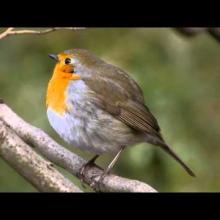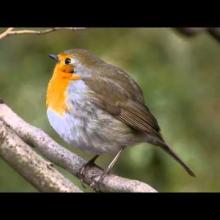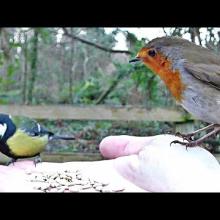

Join BirdNote tomorrow, November 30th!
Illustrator David Sibley and actor H. Jon Benjamin will face off in the bird illustration battle of the century during BirdNote's Year-end Celebration and Auction!
Some migratory songbirds such as European Robins have special light-sensitive proteins called cryptochromes in their eyes. New research suggests how the cryptochromes could alter their behavior in the presence of magnetic fields, giving birds a visual cue for north and south. Other birds can navigate with the help of a mineral called magnetite in their beaks.
BirdNote®
Can Birds “See” Magnetic Fields?
Written by Ariana Remmel
This is BirdNote.
[European Robin song https://macaulaylibrary.org/asset/89108201]
While a bird’s eye view lets a migratory songbird like this European Robin keep track of important landmarks along its route, a special protein in its eyes might let it ”see” Earth’s magnetic field. It’s like a hiker using a compass to find true north.
[European Robin song https://macaulaylibrary.org/asset/89108201]
As European Robins get closer to migration, their eyes produce more of a light-detecting protein called a cryptochrome. Non-migratory birds have this eye protein, too, but at lower levels.
To understand why migratory birds might need more of this protein, scientists compared the cryptochrome proteins from European Robins -- birds that do migrate -- to those from chickens and pigeons, birds that don’t migrate. They found that only the robins’ cryptochrome changed its behavior in the presence of a weak magnetic field. This feature could make the birds’ field of view appear darker in the direction of a magnetic field line, letting them visualize which way is north.
[Rock Pigeons cooing https://macaulaylibrary.org/asset/315571941 and https://macaulaylibrary.org/asset/167946961]
Pigeons do have a magnetic mineral called magnetite embedded in their beaks. So, even though they may not be able to see magnetic fields, they can detect them. This is what makes homing pigeons so good at finding their way back home!
Birds on the move may use one or both ways of sensing magnetic fields.
[European Robin song https://macaulaylibrary.org/asset/89108201]
For BirdNote, I’m Mark Bramhill.
###
Senior Producer: Mark Bramhill
Producer: Sam Johnson
Managing Editor: Jazzi Johnson
Content Director: Jonese Franklin
Bird sounds provided by The Macaulay Library of Natural Sounds at the Cornell Lab of Ornithology, Ithaca, New York. European Robin ML 89108201 recorded by D. Garcia-Hall, Rock Pigeon ML 315571941 recorded by A. Finch, and Rock Pigeon ML 167946961 recorded by P. Marvin.
BirdNote’s theme was composed and played by Nancy Rumbel and John Kessler.
© September 2021 BirdNote October 2024 Narrator: Mark Bramhill
migration-31-2021-09-22 migration-31
Reference: https://www.nature.com/articles/s41586-021-03618-9






